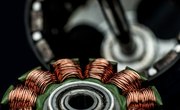
As one of the most influential scientists of the 19th century, Michael Faraday took inspiration from the work of Danish physicist Hans Christian Oersted, who realized in 1820 that an electric current could be changed into a magnetic force. This discovery led to Faraday's Law and the first electromagnetic direct current (DC) generator called Faraday's disk. As a type of homopolar – balanced polarity – generator, a copper disk positioned and spinning between the arms of a horseshoe magnet generated electricity from the center of the copper disk out to its rim.
TL;DR (Too Long; Didn't Read)
The simplest DC generators contain an armature or coil that spins inside a rotating split-ring commutator with brushes or electrical contacts attached to generate direct current electricity. The current changes direction through the commutator, which causes the armature and loops to rotate inside the magnetic field. DC generators convert mechanical energy into electrical energy.
DC Generator Parts
Most simple DC generators contain the same basic parts as simple alternating current (AC) generators do. Both ends of a multiturn coil or armature that rotates consistently inside a magnetic field attach to opposite halves of a split-ring commutator, which rotates in alignment with the coil. Stationary metal brushes connect the split ring to the external electrical circuit.
Split-Ring Commutator Purpose
The purpose of the split-ring commutator is to make certain that the field that is generated, which consists of both electric and magnetic elements and is seen by the outside circuit, is the same as the electromagnetic field surrounding the spinning coil for half of its rotation period. The connection between the external circuit and the spinning coil reverses each half-period of rotation. This allows for the metal brush positions to be recalibrated so the connection between the spinning coil and outside circuit reverses when the electromagnetic field produced around the coil passes through zero.
DC Generators Inside Automobiles
The alternator inside your vehicle is a type of DC generator. Inside the engine compartment, you'll find the alternator with a voltage regulator attached to a bracket mounted to the engine body. A pulley on the front holds a belt that attaches to the engine's crankshaft by a similar pulley. When the battery starts the car and the crankshaft spins, turning the belt on the alternator, it causes the spinning elements inside the alternator to rotate to create the electricity.
When the vehicle is running, the electricity it uses comes from the alternator. The alternator also recharges the battery, so if the car's headlights dim while you are driving and the car suddenly dies, don't look to the battery as the problem – it is more likely to be a failing alternator.
References
About the Author
As a journalist and editor for several years, Laurie Brenner has covered many topics in her writings, but science is one of her first loves. Her stint as Manager of the California State Mining and Mineral Museum in California's gold country served to deepen her interest in science which she now fulfills by writing for online science websites. Brenner is also a published sci-fi author. She graduated from San Diego's Coleman College in 1972.
